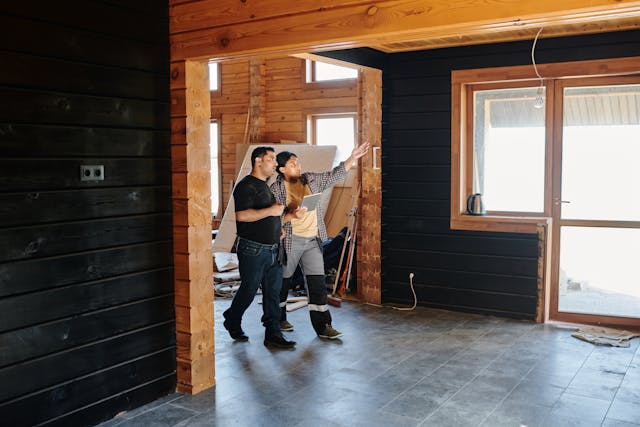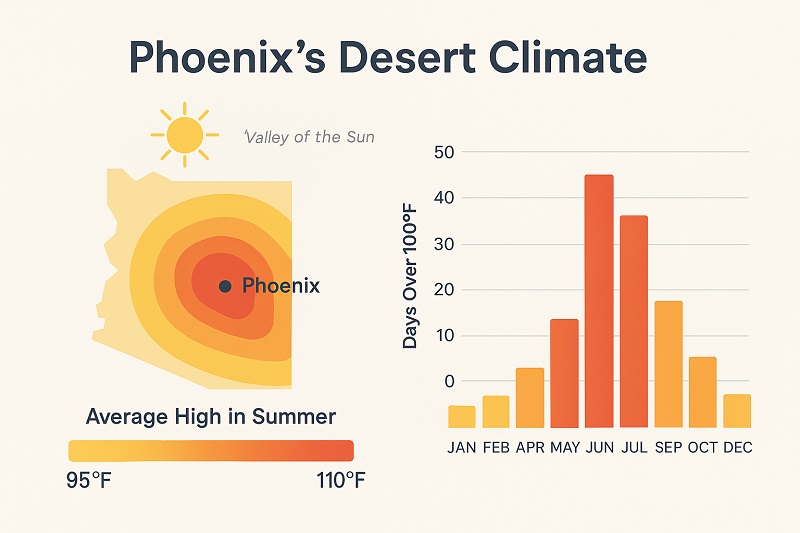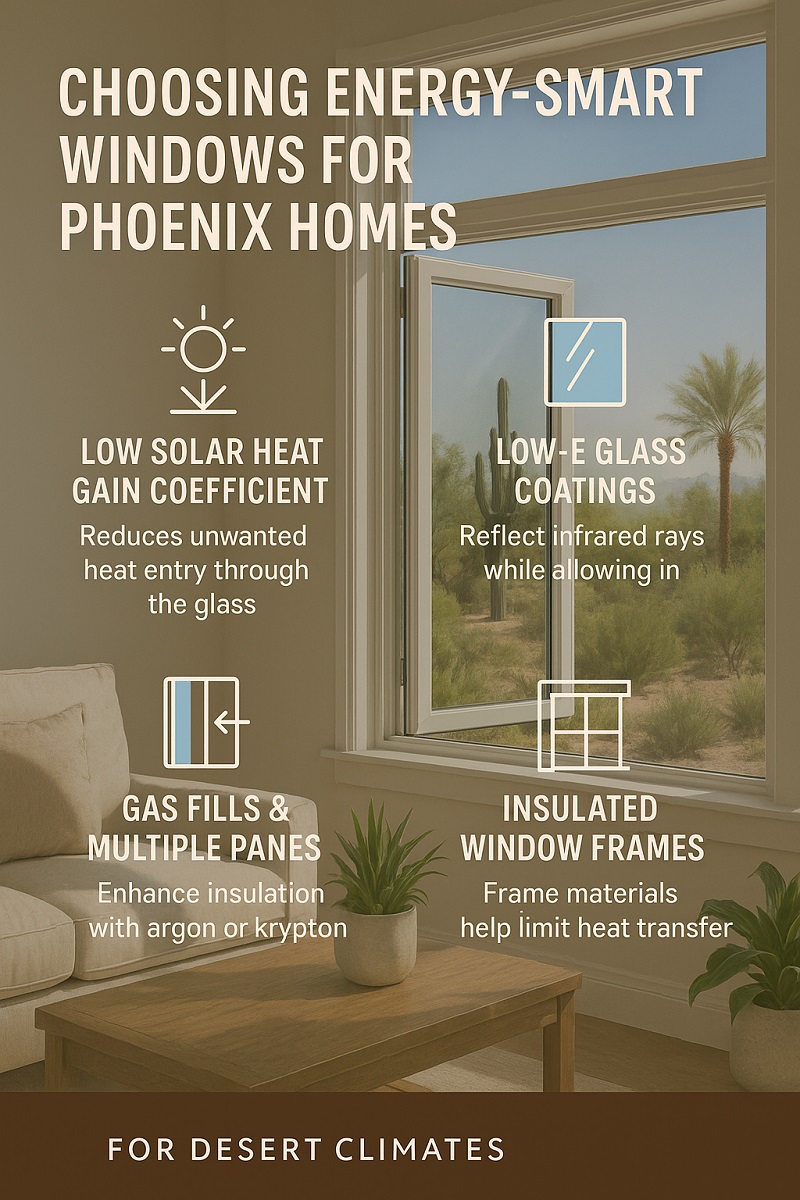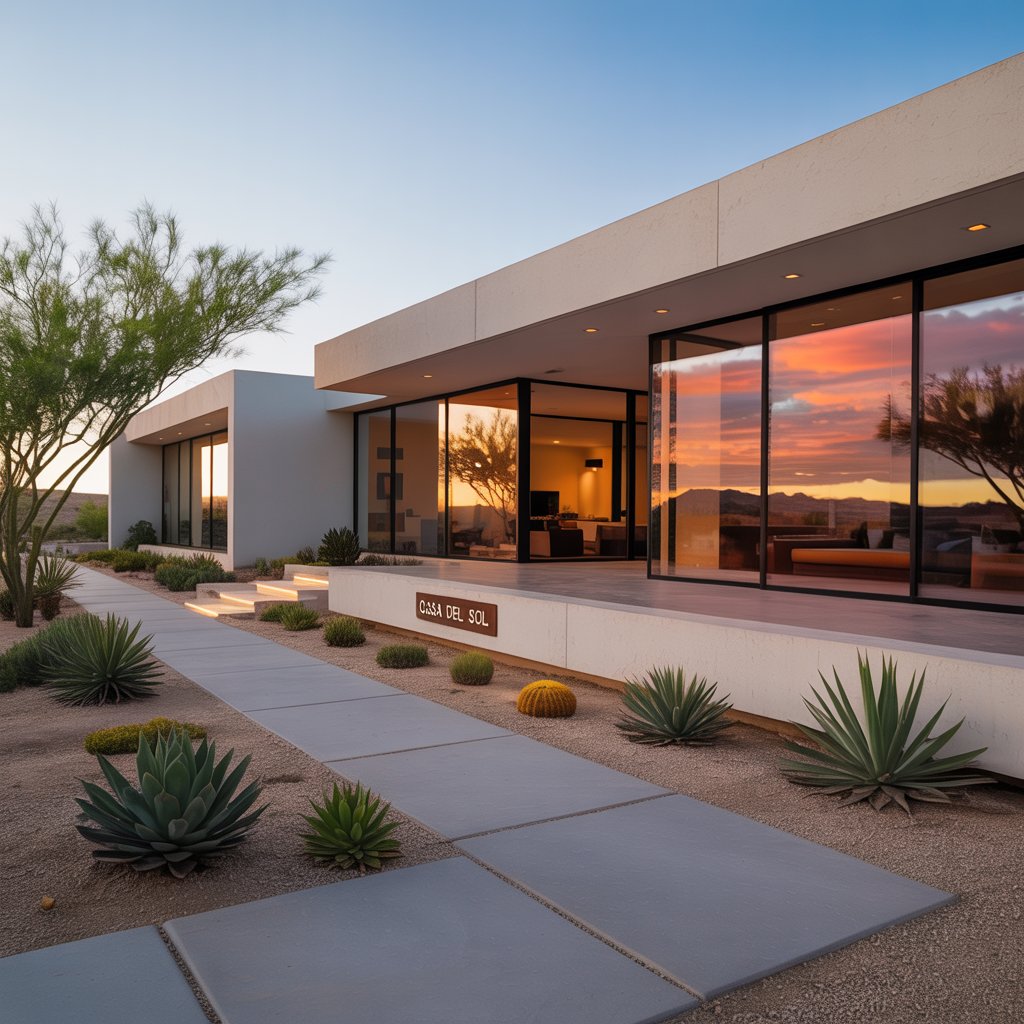In the Valley of the Sun, where temperatures soar for much of the year, windows play a crucial role in a home’s comfort and energy efficiency. While picturesque views and bright natural light are welcome, unwanted heat gain is not. For homeowners in Phoenix, upgrading to energy‑efficient windows is more than a cosmetic improvement—it’s a smart investment in year-round comfort, utility savings, and property value.
This guide explores how to choose the right windows for desert living, focusing on energy performance, style, and materials best suited for Phoenix homes.
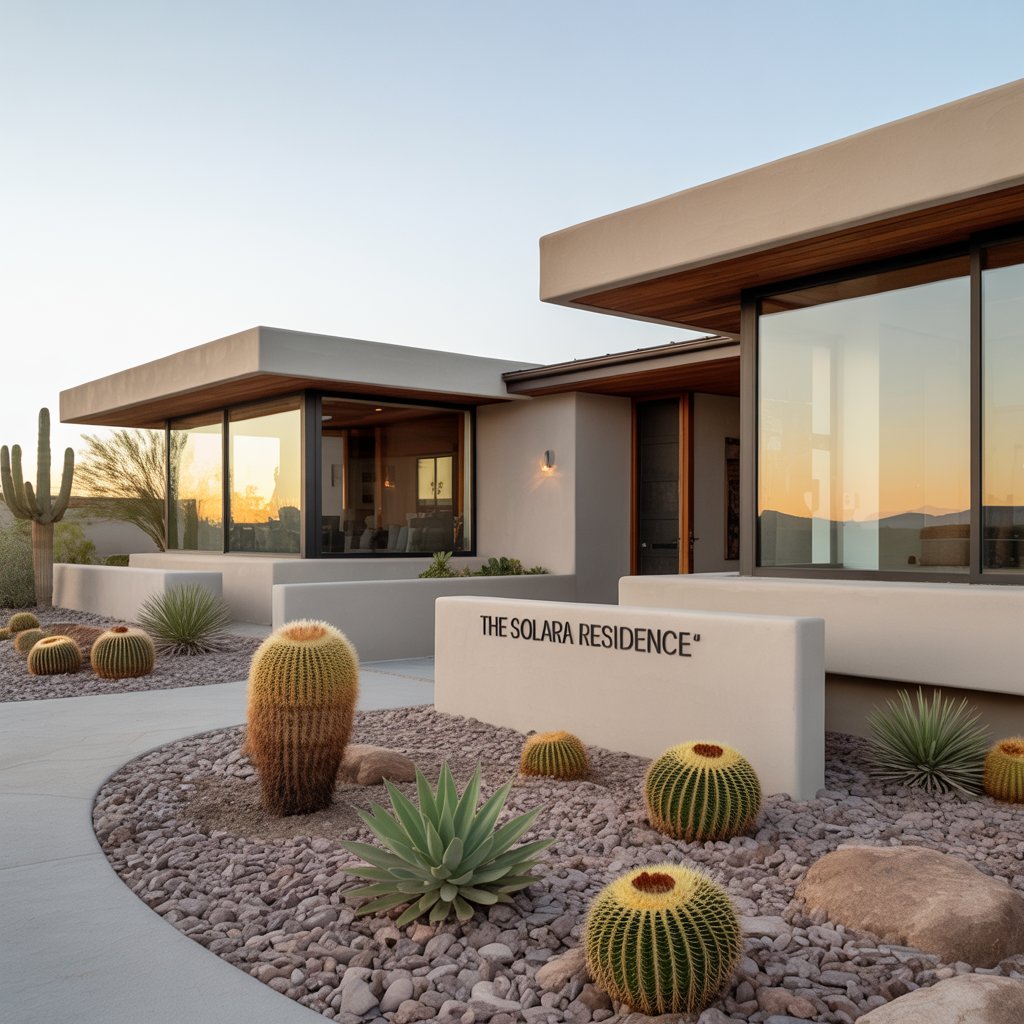
Phoenix’s Desert Climate & Homebuilding Realities
Phoenix, Arizona—known as the “Valley of the Sun”—experiences one of the harshest desert climates in the United States. With summer highs regularly exceeding 110°F and more than 300 sunny days per year, homes here are under constant pressure to stay cool without racking up massive energy bills.
A Hot, Dry Challenge
According to the National Weather Service, Phoenix saw 54 days over 110°F in 2024, with a record-breaking 31 consecutive days above that mark. These extremes don’t just impact comfort—they also strain HVAC systems and drive energy use sky-high. The average summer electric bill for a single-family home in Phoenix exceeds $200/month, primarily due to air conditioning.
But it’s not just the heat. The region’s low humidity and UV intensity can take a toll on building materials. Window seals dry out, frames warp, and unprotected interiors fade faster than in more temperate regions.
Building for the Desert
Modern Phoenix homes are increasingly being designed with energy-smart strategies in mind. Builders and homeowners alike are leaning into materials and layouts that combat the heat:
| Trend | Why It Matters in Phoenix |
|---|---|
| Light-colored or reflective roofs | Reduces heat absorption and lowers attic temperatures |
| Deep roof overhangs & awnings | Provide passive shading for windows and doors |
| Insulated concrete walls | Boost thermal mass and regulate interior temperature |
| Advanced window technologies | Crucial for managing solar gain and maintaining indoor comfort |
| Orientation-based window placement | Minimizes west-facing glass to avoid the harshest afternoon sun |
The City of Phoenix Building Code also reflects this priority. The 2021 International Energy Conservation Code (IECC) adopted by Phoenix mandates higher standards for thermal performance, including for fenestration (windows and doors). Homes that meet these standards often qualify for Energy Star® certification or local utility incentives from providers like SRP (Salt River Project) and APS (Arizona Public Service).
Older Homes Face Bigger Challenges
A significant portion of Phoenix’s housing stock—especially homes built before the early 2000s—lack the insulation and window performance needed for today’s climate demands. Many still use single-pane or aluminum-frame windows, which are poor insulators and highly conductive. In a desert climate, that’s a recipe for high bills and uncomfortable interiors.
Why Energy‑Smart Windows Matter in Desert Climates
Older windows, especially those with single-pane glass or aluminum frames, are among the top contributors to energy loss in a home. In high-temperature regions like Phoenix, poorly insulated windows allow intense solar heat to pour inside, pushing cooling systems to work harder and increasing energy bills.
Modern replacement windows help control this heat transfer. They’re engineered to reflect heat, insulate against the sun’s intensity, and maintain a more stable indoor temperature throughout the seasons. For homes in Arizona, this means cooler interiors during extreme summers and greater control over monthly cooling costs.
Key Features to Look for in Energy-Efficient Windows
When shopping for energy-smart windows, it’s important to understand the features that directly impact performance in hot, dry climates like Phoenix.
Low Solar Heat Gain Coefficient (SHGC)
SHGC measures how much solar heat a window allows into the home. For desert climates like Arizona, a lower SHGC rating is better, as it reduces the amount of unwanted heat entering through the glass. This feature helps keep indoor spaces cooler without relying solely on air conditioning.
Low-E Glass Coatings
Low-emissivity (Low‑E) coatings are microscopic layers applied to the glass that reflect infrared and ultraviolet rays. They reduce heat transfer without sacrificing visible light, meaning you can enjoy sunlight without the overheating. Low-E windows also help protect furniture, floors, and curtains from UV damage.
Gas Fills Between Panes
Most modern energy-efficient windows include inert gas fills like argon or krypton between panes. These gases act as invisible insulation, reducing thermal transfer far more effectively than regular air. For homes in Phoenix, gas-filled dual- or triple-pane windows are an excellent defense against outdoor heat.
Dual- or Triple-Pane Construction
Double-pane glass is a standard choice for window replacement in Phoenix, AZ, but triple-pane options are gaining popularity for their enhanced insulation. The added layer increases energy savings, reduces noise, and improves indoor comfort even further—especially helpful during the hottest months of the year.
Insulated Window Frames
The frame material is just as important as the glass. Look for materials that resist heat transfer, such as fiberglass, composite, or vinyl. These frame types often include thermal breaks—built-in barriers that help stop heat from flowing through the window structure.
Choosing the Right Window Styles for Phoenix Homes
Not every window style performs the same in hot, dry conditions. Beyond looks, functionality and placement can greatly influence comfort and efficiency.
- Casement Windows: Hinged on the side and operated with a crank, casement windows offer a tight seal when closed, making them one of the most energy-efficient styles available.
- Awning Windows: Similar to casement but hinged at the top, awning windows can remain open during light rain and still block direct sunlight, making them versatile for shaded areas.
- Sliding Windows: A practical choice for wider openings, sliders are easy to operate and offer great views. While slightly less efficient than casements, they can still perform well when properly installed.
- Picture & Garden Windows: These fixed or outward-projecting styles maximize light and visibility. They’re best suited for shaded exposures or rooms that benefit from extra brightness without needing ventilation.
When selecting styles, consider the direction your windows face. South- and west-facing walls typically receive the most heat and sunlight, so installing more insulated styles in those areas is wise.
Rebates, Cost Savings, and Long-Term Value
Installing high-performance windows can lead to significant savings over time. Not only do they reduce your monthly energy costs, but they can also increase your home’s value. Real estate professionals often cite new, energy-efficient windows as a top selling point for homes in warm climates.
Additionally, energy-smart windows can often qualify for regional utility rebates or incentives, helping to offset the initial investment. The return on investment typically improves even further when you consider lower HVAC maintenance costs and enhanced indoor comfort.
Installation Matters: What to Expect from a Professional
Even the best window won’t perform as expected if it’s poorly installed. That’s why professional measurement and expert installation are essential for homeowners investing in window replacement in Phoenix, AZ.
Here’s what to look for in a quality installation:
- Precise Measurements: Custom-fitted windows ensure a tight, efficient seal that eliminates air leaks. Accurate measurements down to 1/8 of an inch can make a noticeable difference.
- Proper Sealing and Flashing: Professionals will use the right materials and techniques to seal the window opening, preventing moisture intrusion and air drafts.
- Quality Materials: From the frame to the fasteners, high-quality components ensure durability in the face of Phoenix’s intense climate.
- Licensed and Experienced Technicians: Certified installers understand how to tailor the process to local building codes and environmental conditions.
Choosing a reputable provider ensures your new windows perform at their full potential for years to come.
Smart Maintenance Tips for Desert Windows
Once installed, maintaining your windows helps extend their lifespan and efficiency:
- Clean the Glass and Frames Regularly: Dust, pollen, and hard water buildup can degrade finishes and visibility.
- Inspect Weatherstripping: Check for cracks or gaps and replace as needed to maintain a proper seal.
- Re-Caulk as Needed: The intense Arizona sun can wear down caulk over time—check annually for areas that need resealing.
- Use Exterior Shade Structures: Overhangs, awnings, or solar screens can further protect windows from direct sunlight and improve energy performance.
Wrapping It Up
Choosing energy-efficient windows tailored for desert conditions isn’t just a trend—it’s a practical move for any Phoenix homeowner looking to enhance comfort and reduce energy use. With features like Low-E coatings, insulated frames, and precise installation, modern window replacements are built to withstand the heat while elevating your home’s style and value.
If you’re ready to explore options for a window upgrade, focus on solutions designed specifically for hot, sun‑soaked environments. A well‑chosen window not only keeps your home cooler but also puts your energy dollars to smarter use—all while embracing Arizona’s brilliant sunshine the way it was meant to be.


